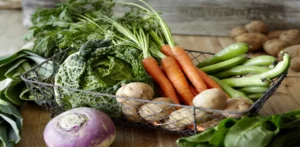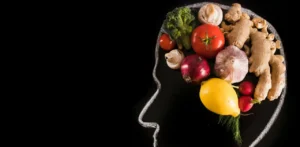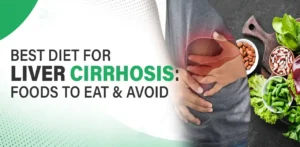Contents
- 1 Pollotarian Meaning: Unveiling the “Poultry Powerhouse”
- 2 Exploring the Motivations Behind the Pollotarian Diet
- 3 Pros and Cons of the Pollotarian Diet: Weighing the Options
- 4 Fueling Your Body: Foods to Embrace on the Pollotarian Diet
- 5 Optional Exclusions (Depending on Individual Choices):
- 6 Navigating the Culinary Landscape: A Pollotarian Diet Menu and Recipes
- 7 Beyond the Plate: Essential Tips for Pollotarian Success
- 8 IntRest: Your Partner in Healthy Pollotarian Dining
- 9 Embracing the Pollotarian Lifestyle: Potential Challenges and Long-Term Sustainability
In the ever-evolving world of healthy eating, new dietary trends seem to emerge every season. Among these, the pollotarian diet has gained traction in recent years. But what exactly is it, and is it the right choice for you? This comprehensive guide will explore the ins and outs of the pollotarian diet, equipping you with the knowledge to make informed decisions about your well-being.
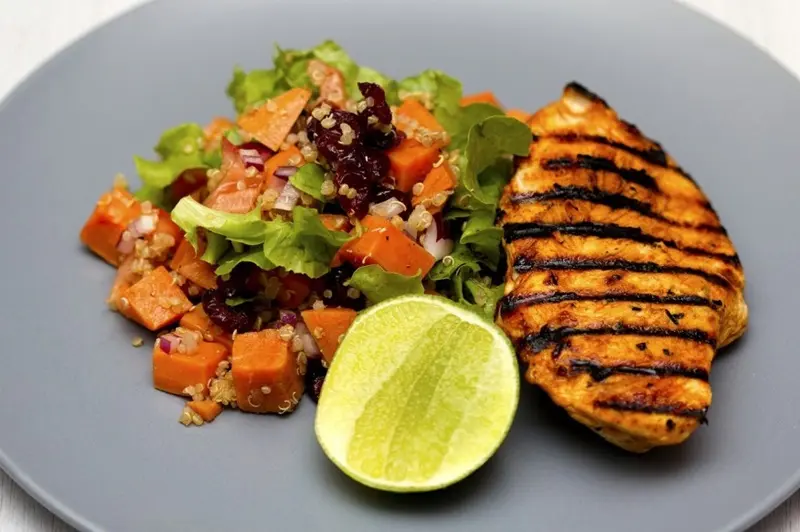
Pollotarian Meaning: Unveiling the “Poultry Powerhouse”
The term “pollotarian” comes from the Spanish word “pollo,” meaning chicken. In essence, a pollotarian diet is a form of semi-vegetarianism that allows poultry (chicken, turkey, duck) as the only meat source. Red meat, pork, and typically fish and seafood are excluded. Some pollotarians may also choose to incorporate eggs and dairy into their diet, while others opt for a completely plant-based approach alongside the poultry.
Also Read: “What Is Lacto-Vegetarian? Diet, Benefits & Meal Plans”

Exploring the Motivations Behind the Pollotarian Diet
People embrace the pollotarian lifestyle for various reasons. Here are some of the most common:
- Health Concerns: Studies suggest a link between red meat consumption and an increased risk of certain cancers, heart disease, and type 2 diabetes. By eliminating red meat, pollotarians aim to mitigate these health risks.
- Environmental Impact: The environmental footprint of the red meat industry is significant. Reducing red meat intake can be a way to lessen one’s environmental impact.
- Ethical Considerations: Some individuals choose pollotarianism due to ethical concerns surrounding factory farming practices for red meat production.
- A Stepping Stone to Vegetarianism: The pollotarian diet can be a stepping stone for those considering a full transition to vegetarianism. It allows for a gradual shift while still providing essential nutrients found in poultry.
- Taste Preference: Some simply prefer the taste of poultry to red meat.

Pros and Cons of the Pollotarian Diet: Weighing the Options
Like any dietary approach, the pollotarian diet has its advantages and disadvantages. Let’s delve into both sides:
Pros:
- Reduced Risk of Chronic Diseases: By eliminating red meat, pollotarians may decrease their risk of heart disease, certain cancers, and type 2 diabetes.
- Improved Gut Health: The emphasis on plant-based foods in the pollotarian diet can promote a healthy gut microbiome, crucial for overall well-being.
- Environmentally Friendly: Reducing red meat consumption can contribute to a smaller environmental footprint.
- Ethical Considerations: For those concerned about factory farming practices, the pollotarian diet aligns with their ethical values.
- Potential for Weight Loss: The lean protein content of poultry and the focus on plant-based foods can promote satiety and potentially aid in weight management efforts (consult a doctor or registered dietician for personalized advice).
Cons:
- Nutrient Deficiencies: Strict adherence to a pollotarian diet without proper planning may lead to deficiencies in iron, vitamin B12, and zinc, all primarily found in red meat. Supplementation or incorporating other dietary sources may be necessary.
- Social Challenges: In social settings where red meat is often a staple, a pollotarian diet might require planning and communication to ensure suitable options are available.
- Limited Restaurant Choices: Finding restaurants with a variety of pollotarian-friendly dishes can be challenging, especially for those who avoid fish and seafood.
Also Read: “Discover the Best Mediterranean Diet Options”
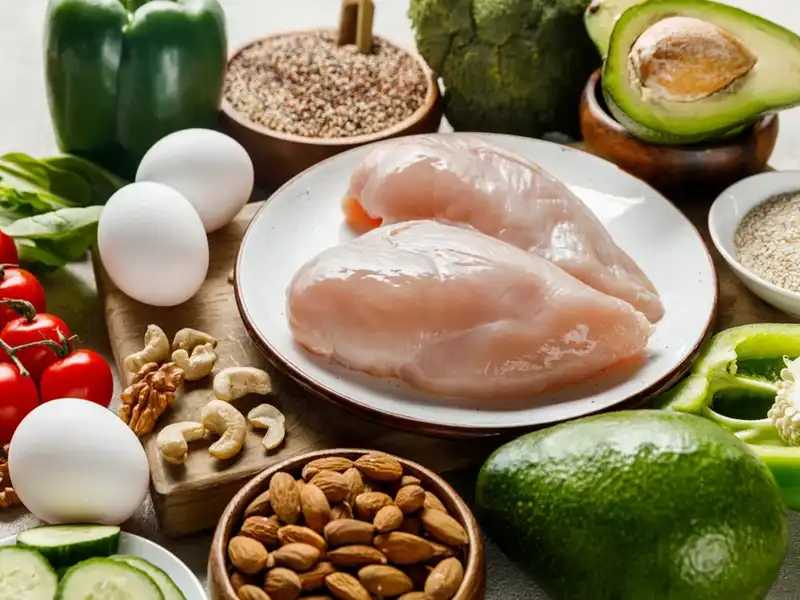
Fueling Your Body: Foods to Embrace on the Pollotarian Diet
A balanced pollotarian diet incorporates a variety of nutrient-rich foods. Here’s a breakdown of the key categories:
- Poultry: Chicken, turkey, and duck are excellent sources of lean protein, essential for building and maintaining muscle mass.
- Plant-Based Proteins: Beans, lentils, tofu, tempeh, and nuts offer valuable plant-based protein alternatives.
- Fruits and Vegetables: A rainbow of fruits and vegetables provides essential vitamins, minerals, and fiber for optimal health.
- Whole Grains: Opt for whole grains like brown rice, quinoa, and whole-wheat bread for sustained energy and healthy fiber intake.
- Healthy Fats: Include healthy fats from sources like avocados, nuts, seeds, and olive oil to support nutrient absorption and satiety.
- Dairy (Optional): Milk, cheese, and yogurt (if tolerated) can contribute to calcium intake Foods to Avoid on the Pollotarian Diet
The core principle of the pollotarian diet revolves around eliminating red meat and pork. Here’s a breakdown of the key foods to avoid:
Red Meat:
- Beef (including steaks, burgers, ground beef)
- Lamb (including chops, roasts, ground lamb)
- Pork (including chops, bacon, sausage, ham)
- Game Meat (including bison, venison, elk)
Other Considerations:
- Processed Meats: While not technically “red meat,” processed meats like hot dogs, sausages, deli meats, and salami are generally discouraged due to their high sodium content, unhealthy fats, and nitrates.
- Organ Meats: Offal meats like liver, kidney, and heart are often excluded as they are a concentrated source of iron and other nutrients typically found in red meat, which pollotarians aim to reduce.
Optional Exclusions (Depending on Individual Choices):
- Fish and Seafood: Strict pollotarians avoid fish and seafood altogether. However, some individuals who identify as “pesco-pollotarians” incorporate fish and seafood alongside poultry in their diet.
- Dairy: Some pollotarians choose to eliminate dairy products like milk, cheese, and yogurt due to ethical concerns or potential digestive issues. Others choose to include them for their calcium and protein content.
Remember: The pollotarian diet is a flexible approach. The core principle is to eliminate red meat and pork, but individual choices regarding fish, seafood, and dairy can vary. It’s important to find a version of the diet that aligns with your health goals, ethical beliefs, and taste preferences.
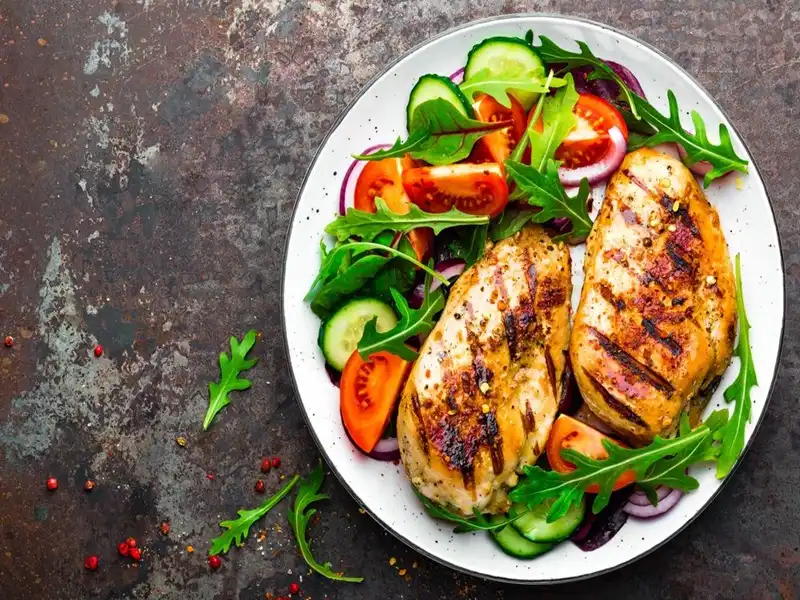
Now that you understand the core principles of the pollotarian diet, let’s explore how to translate them into delicious and nutritious meals.
Sample Pollotarian Meal Plan:
This sample plan provides a framework for a balanced and enjoyable pollotarian diet. Feel free to adjust portion sizes and ingredients based on your individual needs and preferences.
Day 1:
- Breakfast: Scrambled eggs with chopped vegetables (spinach, mushrooms, peppers) and whole-wheat toast.
- Lunch: Grilled chicken breast salad with mixed greens, quinoa, avocado, and a light vinaigrette dressing.
- Dinner: Turkey stir-fry with broccoli, carrots, bell peppers, and brown rice.
Day 2:
- Breakfast: Greek yogurt with berries, granola, and a sprinkle of chia seeds.
- Lunch: Lentil soup with whole-wheat bread and a side salad.
- Dinner: Baked salmon (for pesco-pollotarians) with roasted sweet potatoes and asparagus.
Day 3:
- Breakfast: Smoothie made with almond milk, banana, spinach, protein powder, and a dollop of peanut butter.
- Lunch: Chicken fajitas with whole-wheat tortillas, black beans, salsa, and avocado.
- Dinner: Vegetarian chili with cornbread and a side salad.
Day 4:
- Breakfast: Oatmeal with chopped nuts, sliced apple, and a drizzle of honey.
- Lunch: Leftover turkey stir-fry from Day 1.
- Dinner: Tofu scramble with turmeric, vegetables, and whole-wheat toast.
Day 5:
- Breakfast: Whole-wheat pancakes with fruit topping and a drizzle of maple syrup.
- Lunch: Chickpea salad sandwich on whole-wheat bread with lettuce and tomato.
- Dinner: Chicken kabobs with grilled vegetables and brown rice.
Beyond the Plate: Essential Tips for Pollotarian Success
Planning and Preparation:
- Meal Planning: Dedicate some time each week to plan your meals. This will help you stay on track and prevent unhealthy last-minute choices.
- Grocery Shopping: Stock your pantry and fridge with pollotarian-friendly staples.
- Meal Prep (Optional): Consider prepping some meals or ingredients in advance to save time and ensure healthy choices throughout the week.
Dining Out:
- Research Restaurants: Use apps like IntRest to find restaurants with pollotarian-friendly options. IntRest categorizes menus based on dietary needs, making it easy to discover suitable dishes.
- Communicate Your Needs: Don’t hesitate to ask servers about menu modifications or hidden ingredients to ensure your meal aligns with your dietary choices.
Embrace the Journey:
- Listen to Your Body: Pay attention to how your body responds to different foods. Adjust your portions or ingredients accordingly.
- Don’t Be Afraid to Experiment: Explore new recipes and flavors to keep your meals exciting and delicious.
- Seek Support: Connect with online communities or find a registered dietician who can provide personalized guidance on your pollotarian journey.
IntRest: Your Partner in Healthy Pollotarian Dining
Whether you’re a seasoned pollotarian or just starting your exploration, IntRest is here to simplify your healthy eating journey. Our comprehensive restaurant database categorizes menus based on dietary needs and preferences.
With IntRest, you can easily find restaurants near you that offer delicious and pollotarian-friendly dishes. Simply search for “pollotarian” or “poultry” options, and IntRest will guide you towards restaurants that cater to your dietary choices.
Embracing the Pollotarian Lifestyle: Potential Challenges and Long-Term Sustainability
The pollotarian diet, like any dietary approach, comes with its own set of challenges. Here’s how to navigate them for long-term success:
Overcoming Social Hurdles:
- Navigating Social Gatherings: Communicate your dietary preferences beforehand and offer to bring a dish you can enjoy. Many potlucks can be easily adapted to accommodate pollotarians.
- Dining Out with Friends: Suggest restaurants with diverse menus or utilize IntRest’s filtering system to find suitable options beforehand.
- Be Patient and Understanding: Not everyone will understand your dietary choices. Be patient and politely explain your reasons when necessary.
Ensuring Nutrient Adequacy:
- Iron: Red meat is a significant source of iron. Include iron-rich plant-based alternatives like lentils, beans, tofu, fortified cereals, and dark leafy greens in your diet. Consider consulting a doctor about iron supplementation if necessary.
- Vitamin B12: Vitamin B12 is primarily found in animal products. For strict pollotarians who exclude eggs and dairy, fortified plant-based milks and cereals, or a B12 supplement, can be crucial.
- Zinc: Zinc is another essential nutrient found in red meat. Pumpkin seeds, chickpeas, lentils, and fortified cereals are good plant-based sources of zinc.
Maintaining Motivation:
- Focus on the Benefits: Remind yourself of the positive impact of the pollotarian diet on your health, the environment, and potentially, animal welfare.
- Celebrate Milestones: Acknowledge and celebrate your progress, whether it’s increased energy levels, improved digestion, or weight management success.
- Find a Support System: Connect with online communities or join a local vegetarian or vegan group to find encouragement and share experiences with like-minded individuals.
The Final Bite: A Sustainable and Fulfilling Dietary Choice
The pollotarian diet offers a balanced and potentially sustainable approach to healthy eating. By incorporating a variety of nutrient-rich foods, planning your meals, and utilizing resources like IntRest, you can navigate potential challenges and make informed choices. Remember, a healthy and enjoyable pollotarian lifestyle is achievable with dedication and a sense of adventure. So, embark on your pollotarian journey with confidence, explore new flavors, and experience the positive impact on your body and the world around you!

